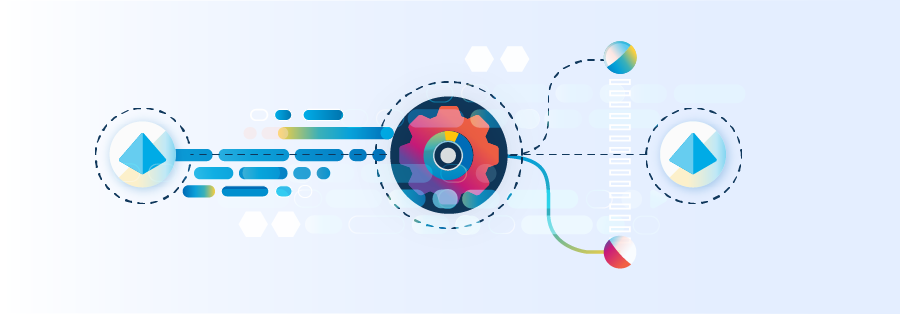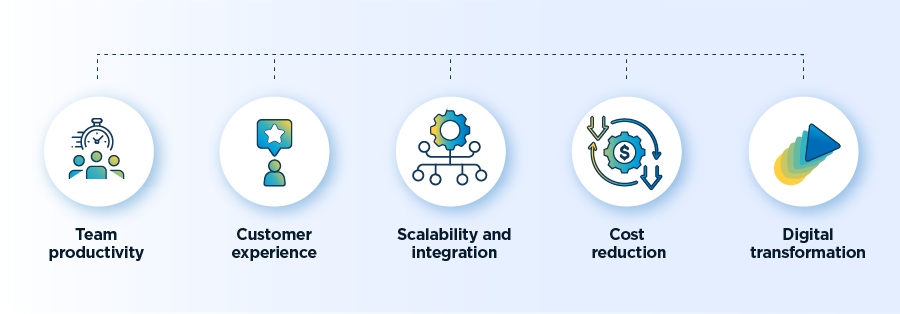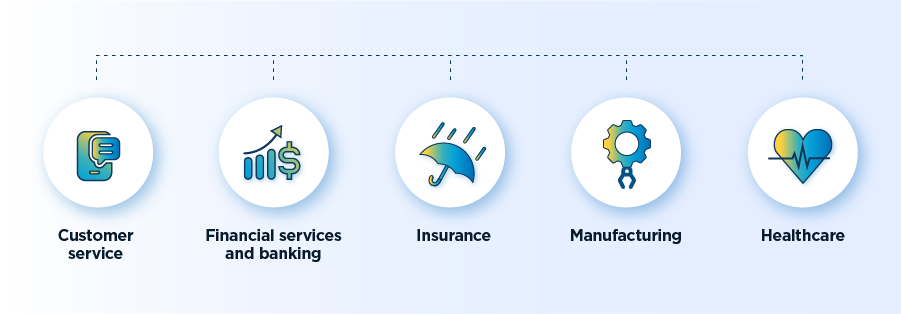AI Automation: The Complete Guide to Transforming Your Business Operations in 2025
Listen to the AI Automation Podcast
A quick summary of key points covered in this article
of companies see efficiency gains with AI automation
reduction in errors with automated processes
higher customer satisfaction with AI-powered service
higher profit margins with comprehensive AI automation
AI automation is changing the game for businesses of all sizes. Recent data shows that 75% of companies implementing AI automation have seen at least a 25% increase in operational efficiency. Isn’t it time your business joined this revolution?
In today’s fast-moving business world, staying competitive means working smarter, not harder. AI automation combines artificial intelligence with workflow automation to handle repetitive tasks, make intelligent decisions, and free up your team for more creative work.
By the end of this guide, you’ll understand what AI automation is, how it works, its benefits across industries, and exactly how to implement it in your business. You’ll also get insights into common challenges and what the future holds for this transformative technology.
Table of Contents
Understanding AI Automation Fundamentals
What is AI Automation?
AI automation combines artificial intelligence technologies with automated workflows to perform tasks that once required human intervention. Unlike traditional automation that follows rigid, rule-based instructions, AI automation can learn, adapt, and make decisions based on data.

Think of traditional automation as a train on tracks – it can only go where the tracks lead it. AI automation, on the other hand, is more like a self-driving car that can navigate changing conditions, choose alternative routes, and improve its performance over time.
For example, a traditional automated email system might send the same template to everyone on a list. An AI-automated system can analyze customer data, previous interactions, and current behaviors to personalize messages, determine optimal sending times, and even predict which customers are most likely to respond.
How AI Automation Differs from Traditional Automation
| Traditional Automation | AI Automation |
|---|---|
| Follows fixed rules | Adapts and learns |
| Handles structured data only | Processes unstructured data (text, images, etc.) |
| Breaks when conditions change | Adjusts to new conditions |
| Requires constant human updates | Improves itself through learning |
| Performs repetitive tasks | Makes decisions and predictions |
Key Components of AI Automation Systems
A complete AI automation system typically includes:
- Data Collection Layer: Gathers information from various sources
- Processing Engine: Analyzes data using AI algorithms
- Decision Engine: Makes choices based on analysis
- Action Layer: Executes decisions through automated tools
- Feedback Loop: Collects results to improve future performance

The Evolution of AI Automation
AI automation didn’t appear overnight. Its development follows a clear progression:
- 1950s-1990s: Basic automation with limited rule-based systems
- 1990s-2010: Introduction of machine learning for pattern recognition
- 2010-2020: Deep learning breakthroughs enabling complex decision-making
- 2020-Present: Integration of generative AI and advanced language models into automation workflows
Today’s AI automation systems represent decades of advancement in both artificial intelligence and process automation technologies. The recent explosion of large language models (LLMs) like GPT-4 has dramatically expanded what’s possible, allowing even small businesses to implement sophisticated automation solutions previously available only to major enterprises.
How AI Automation Works
The “magic” behind AI automation is actually sophisticated technology working across multiple layers. Let’s break it down into understandable pieces.
AI Automation Components
Core Technologies Driving AI Automation
Modern AI automation relies on several key technologies:
- Machine Learning (ML): Systems that learn from data rather than being explicitly programmed
- Natural Language Processing (NLP): Technology that helps computers understand human language
- Computer Vision: Enables systems to “see” and interpret visual information
- Deep Learning: Advanced neural networks that can identify complex patterns
- Robotic Process Automation (RPA): Software robots that perform routine business processes
These technologies work together to create systems that can understand information, make decisions, and take actions without constant human oversight.
The Role of Data
Data is the fuel that powers AI automation. These systems require:
- Historical Data: To learn patterns and establish baselines
- Real-Time Data: To make immediate decisions
- Feedback Data: To improve performance over time
The quality of data directly impacts the quality of automation. Poor data leads to poor decisions, while clean, comprehensive data enables accurate, effective automation.
Automation Workflows and Decision Processes
A typical AI automation workflow follows these steps:
- Trigger: An event initiates the process (e.g., a customer submits a form)
- Data Collection: The system gathers relevant information
- Analysis: AI analyzes the data and context
- Decision: The system determines the appropriate action
- Execution: Automated tools perform the action
- Feedback: Results are recorded and used for improvement
Each step can involve multiple AI technologies working together. For instance, processing a customer email might use NLP to understand the content, ML to classify the request, and decision engines to determine the appropriate response.
Business Benefits of AI Automation
Implementing AI automation isn’t just about using cool technology—it’s about creating real business value. Here are the concrete benefits companies are experiencing today.

Cost Reduction and Efficiency Gains
AI automation delivers impressive financial benefits:
- Labor Cost Reduction: Companies report 30-40% reductions in process costs
- Error Reduction: 90% fewer mistakes in automated processes versus manual ones
- Processing Speed: Tasks that took hours complete in minutes or seconds
- 24/7 Operation: No downtime for automated systems
A manufacturing company automated quality control with computer vision AI and reduced inspection costs by 65% while increasing detection accuracy by 23%.
Improved Accuracy and Quality
Human errors cost businesses billions yearly. AI automation significantly reduces these errors:
- Consistent Application of Rules: No skipped steps or forgotten procedures
- Data Accuracy: Elimination of manual data entry errors
- Standardized Outputs: Every process follows the same high-quality standard
Financial institutions using AI automation for compliance reporting have reduced regulatory errors by up to 95%, avoiding costly penalties and reputation damage.
Enhanced Customer Experience
Today’s customers expect fast, personalized service. AI automation delivers:
- Immediate Responses: 24/7 customer support via chatbots and automated systems
- Personalization at Scale: Customized experiences for thousands or millions of customers
- Proactive Service: Anticipating needs before customers express them
Companies using AI-powered customer service automation report 35% higher customer satisfaction and 60% faster response times.
Employee Productivity and Satisfaction
Contrary to fears about job loss, AI automation often improves work life:
- Reduced Busywork: Employees spend less time on repetitive tasks
- Focus on Higher Value: More time for creative and strategic work
- Reduced Burnout: Less pressure from monotonous tasks
- Upskilling Opportunities: Employees learn to work with advanced technologies
A healthcare provider automated 85% of their insurance paperwork processing, allowing staff to spend 30% more time on patient care, resulting in improved job satisfaction and reduced turnover.
Competitive Advantage
In today’s fast-moving markets, AI automation creates significant competitive advantages:
- Faster Innovation: More resources available for development
- Greater Agility: Quicker response to market changes
- Data-Driven Decisions: Better insights from automated analytics
- Scalability: Ability to grow without proportional cost increases
Companies that extensively implement AI automation report 3-5% higher profit margins compared to industry peers.
Industry-Specific Applications
AI automation isn’t a one-size-fits-all solution. Here’s how different industries are applying these technologies to solve their unique challenges.
Manufacturing
Manufacturing has embraced AI automation for various processes:
- Predictive Maintenance: AI analyzes equipment data to predict failures before they occur, reducing downtime by up to 50%
- Quality Control: Computer vision systems inspect products 10-30 times faster than humans with greater accuracy
- Supply Chain Optimization: AI forecasts demand and optimizes inventory levels, reducing carrying costs by 15-25%
- Production Planning: Automated scheduling adjusts to changing conditions in real-time
Case Example: An automotive parts manufacturer implemented AI-powered visual inspection systems that reduced defect rates by 32% while increasing production speed by 25%.
Healthcare
The healthcare industry is using AI automation to improve patient care and operational efficiency:
- Patient Scheduling: Automated systems reduce no-shows by 30% through smart reminders
- Medical Records Management: AI extracts and organizes information from various documents
- Diagnostic Support: AI helps identify patterns in medical images and patient data
- Claims Processing: Automated systems process insurance claims with 99.5% accuracy
Case Example: A hospital network automated patient intake with AI, reducing wait times by 40% and administrative costs by $3.2 million annually.
Finance
Financial institutions lead in AI automation adoption:
- Fraud Detection: AI systems identify suspicious transactions in milliseconds
- Loan Processing: Automated underwriting reduces approval time from weeks to days or hours
- Regulatory Compliance: AI ensures adherence to complex and changing regulations
- Algorithmic Trading: Automated systems execute trades based on market conditions
Case Example: A mid-sized bank implemented AI automation for mortgage processing, reducing approval time from 37 days to just 9 days while improving accuracy by 45%.
Retail
Retailers use AI automation to enhance customer experiences and streamline operations:
- Inventory Management: AI predicts optimal stock levels and automates reordering
- Personalized Marketing: Automated systems deliver individualized offers based on customer behavior
- Dynamic Pricing: Prices automatically adjust based on demand, competition, and other factors
- Self-Checkout: Computer vision systems enable frictionless shopping experiences
Case Example: An online retailer implemented AI-powered inventory management that reduced stockouts by 28% and carrying costs by 12%, while improving customer satisfaction scores.
Customer Service
Across all industries, AI automation is transforming customer service:
- AI Chatbots: Handle 70-80% of routine customer queries without human intervention
- Sentiment Analysis: Automatically detect customer mood and escalate as needed
- Case Routing: Direct inquiries to the right department or specialist automatically
- Knowledge Base Automation: Keep self-service information updated automatically
Case Example: A telecommunications company implemented AI-powered customer service automation that reduced call handle times by 40% while increasing first-call resolution rates by 25%.
Implementation Guide
Ready to bring AI automation to your business? Follow this practical roadmap to ensure successful implementation.
Assessing Automation Readiness
Before diving in, evaluate your organization’s readiness:
- Process Documentation: Are your current processes well-documented?
- Data Availability: Do you have the necessary data to train AI systems?
- Technical Infrastructure: Can your current systems support AI automation?
- Team Skills: Does your team have the necessary expertise?
- Change Management: Is your organization prepared for the changes?
Score yourself in each area from 1-5. Areas with lower scores need attention before proceeding.
Identifying High-Value Automation Opportunities
Not all processes are equally suitable for automation. Look for these characteristics:
- High Volume: Tasks performed frequently
- Rule-Based: Follows consistent rules
- Digital Data: Works with information already in digital format
- Error-Prone: Currently experiences human errors
- Time-Consuming: Takes significant staff time
Start by listing 5-10 processes in your organization with these traits. Rank them based on potential ROI, considering both cost savings and strategic value.
Building vs. Buying Solutions
You have three main options for implementing AI automation:
- Pre-built Solutions: Off-the-shelf software for common business processes
- Pros: Fast implementation, proven technology
- Cons: Limited customization, potential integration challenges
- Custom Development: Building solutions tailored to your needs
- Pros: Perfectly aligned with your processes, competitive advantage
- Cons: Higher cost, longer timeframe, requires specialized skills
- Hybrid Approach: Customizing existing platforms
- Pros: Balance of customization and implementation speed
- Cons: May require compromise on some requirements
For your first project, consider starting with a pre-built solution to gain experience before moving to more custom approaches.
Integration Considerations
AI automation doesn’t exist in isolation. Plan for these integration points:
- Data Sources: How will you connect to existing databases and systems?
- User Interfaces: How will employees interact with automated systems?
- Manual Handoffs: Where will humans need to take over from automation?
- Monitoring Systems: How will you track performance?
- Security Protocols: How will you maintain data security?
Create an integration map showing all connection points between your new automation and existing systems.
Step-by-Step Implementation Roadmap
- Start Small: Begin with a pilot project (8-12 weeks)
- Build Your Team: Assemble internal champions and external experts
- Define Success Metrics: Establish clear KPIs before starting
- Develop Training Plan: Prepare your team for new ways of working
- Launch Pilot: Implement your first automation project
- Measure & Refine: Collect data and improve the system
- Expand Gradually: Roll out to additional processes or departments
- Create Center of Excellence: Establish internal expertise to drive future projects
Remember that AI automation is a journey, not a destination. Plan for continuous improvement as technologies and your business needs evolve.
Challenges and Limitations
Despite its benefits, AI automation isn’t without challenges. Understanding these hurdles helps you prepare for and overcome them.
Technical Challenges and Solutions
Common technical obstacles include:
- Data Silos: Information trapped in disconnected systems
- Solution: Implement data integration platforms before automation
- Legacy Systems: Older technology that’s difficult to integrate
- Solution: Use API adapters or robotic process automation as bridges
- Algorithm Limitations: AI that doesn’t handle exceptions well
- Solution: Build human-in-the-loop processes for exceptions
- Scalability Issues: Solutions that work for pilots but not enterprise-wide
- Solution: Design for scale from the beginning, even in small projects
Data Quality and Governance Issues
Poor data undermines automation efforts:
- Incomplete Data: Missing information leads to flawed automation
- Solution: Implement data validation before automation
- Inconsistent Formatting: Variations in data structure
- Solution: Standardize data formats or use preprocessing tools
- Compliance Concerns: Regulatory requirements for data handling
- Solution: Build compliance checks into automated workflows
- Data Security: Protection of sensitive information
- Solution: Implement proper access controls and encryption
Ethical Considerations and Bias
AI systems can perpetuate or amplify biases:
- Training Data Bias: AI learning from biased historical data
- Solution: Audit training data for bias and correct imbalances
- Algorithmic Transparency: Understanding how decisions are made
- Solution: Use explainable AI approaches and maintain documentation
- Fair Access: Ensuring solutions don’t disadvantage certain groups
- Solution: Test outcomes across different demographics
- Job Displacement Concerns: Fear of automation replacing jobs
- Solution: Focus on augmenting workers rather than replacing them
Employee Resistance and Change Management
People often resist new technology:
- Fear of Job Loss: Anxiety about being replaced
- Solution: Clearly communicate how automation will change roles, not eliminate them
- Skills Gaps: Lack of technical knowledge to work with new systems
- Solution: Invest in training and upskilling opportunities
- Process Attachment: Resistance to changing familiar processes
- Solution: Involve employees in design to create buy-in
- Unrealistic Expectations: Disappointment when AI isn’t perfect
- Solution: Set realistic expectations about capabilities and limitations
Future of AI Automation
The field of AI automation continues to evolve rapidly. Here’s what to watch for in the coming years.
Emerging Trends and Technologies
Several innovations are shaping the future:
- Generative AI Integration: Tools like ChatGPT and DALL-E embedded in workflows
- Hyper-Automation: End-to-end automation of complex processes
- Low-Code/No-Code Platforms: Democratization of automation development
- Edge AI: Automation running locally on devices rather than in the cloud
- Quantum Computing: Dramatic acceleration of AI processing capabilities
Predictions for the Next 3-5 Years
Based on current trends, expect these developments:
- AI Assistants Everywhere: Embedded in all business software
- Autonomous Processes: Complete end-to-end workflows with minimal human oversight
- Democratized Development: Business users creating their own automations
- Industry Ecosystems: Shared AI models specific to industry challenges
- Augmented Work: AI-human collaboration becoming standard practice
How Businesses Should Prepare
To stay ahead of the curve:
- Invest in Data Infrastructure: Clean, accessible data is the foundation
- Develop AI Literacy: Ensure your team understands AI concepts
- Create Flexible Architecture: Build systems that can adapt to new technologies
- Experiment Continuously: Maintain ongoing pilots with emerging technologies
- Monitor Ethical Implications: Stay aware of bias and fairness concerns
Case Studies
Learning from real implementations can help you navigate your own AI automation journey.
Small Business Case Study: Regional Accounting Firm
Challenge: A 15-person accounting firm struggled with manual data entry and document processing during tax season, limiting growth.
Solution: Implemented AI-powered document processing to automatically extract and categorize financial information from client documents.
Key Lesson: Even small businesses can achieve significant ROI from targeted AI automation implementations.
Enterprise Case Study: Global Manufacturing Company
Challenge: A global manufacturer with 50+ facilities struggled with inconsistent quality control and high scrap rates.
Solution: Implemented computer vision AI for quality inspection across all production lines, integrated with automated process adjustments.
Key Lesson: Enterprise-wide AI automation requires standardized approaches but can deliver transformative results at scale.
Conclusion
AI automation represents one of the most powerful opportunities for business transformation in our time. From small efficiency improvements to complete process reinvention, these technologies are changing how work gets done across every industry.
The most successful organizations will be those that view AI automation not just as a cost-saving tool but as a strategic capability that creates competitive advantage. By starting small, learning continuously, and scaling thoughtfully, businesses of any size can harness these capabilities.
The question isn’t whether AI automation will transform your industry—it’s whether you’ll be leading that transformation or catching up to competitors who moved first. The time to start is now.
AI Automation Readiness Checklist
Rate your organization on these factors from 1 (not ready) to 5 (fully prepared):
- Process documentation completeness
- Data quality and availability
- IT infrastructure readiness
- Leadership commitment
- Staff technical skills
- Change management capability
- Clear automation goals established
- Budget allocated for implementation
- Potential processes identified
- Success metrics defined
Scoring:
- 40-50: Ready for full implementation
- 30-39: Ready for pilot projects
- 20-29: Need preparation in key areas
- Below 20: Focus on foundational elements before proceeding
Use this checklist to identify gaps and develop your AI automation roadmap.




Comment
nice one